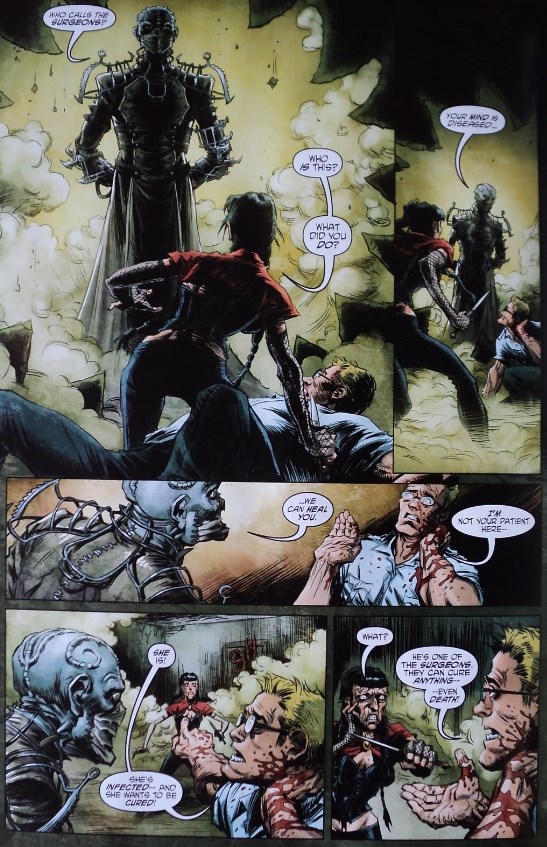We probably had imagined that Penny Dreadful would break free from her imprisonment, but taking a look at her tortured face shows us that this time she’s not taking any prisoners (well, she never does, but still…). Lukas Ketner gives us a very shocking page divided in three panels, the first one shows us how Penny Dreadful tears her own arm apart, dropping it to the floor. Even with only one arm, she still manages to destroy and devour the malignant harpy that had captured her.
Gast, on the other hand, deals with his opponent creatively. Instead of a direct confron-tation he replicates Doctor Vincent Morrow’s spell and summons the Surgeons, these powerful and inhumane creatures that get rid of everything they consider a ‘disease’.
Meanwhile, Witch Doctor faces his nemesis who plans to pour a potent magical potion into the water reservoir of the city. After being beaten down, the doctor realizes that he doesn’t have the time to create a specific spell to neutralize the potion but he can do one thing about it: piss on it (literally). Like I said, I knew I’d be surprised by the final pages of the miniseries but I didn’t think I’d be so amused by the urination tactics of the protagonist.
 |
| Penny Dreadful |
_________________________________________________________________________________________
_________________________________________________________________________________________
Sabía que el desenlace no sería típico en este número final de Mal Practice. Y tenía razón. Brandon Seifert continúa explorando los elementos que hacen de Witch Doctor un personaje único y un cómic innovador. Las tremendas dosis de humor negro, las constantes ironías, los giros argumentales inesperados, el trasfondo médico firmemente insertado en el mundo de lo fantástico, todos estos elementos parecen brillar aquí incluso más que en el capítulo anterior.
 |
| The arrival of the Surgeon / la llegada del Cirujano |
 |
| Is urine powerful enough? / ¿Tiene la orina suficiente poder? |
Gast, por otro lado, se enfrenta a su oponente de manera creativa. En vez de una confrontación directa replica el hechizo del Doctor Vincent Morrow e invoca a los Cirujanos, estas poderosas e inhumanas criaturas que eliminan todo lo que consideran una ‘enferme-dad’.
Mientras tanto, Witch Doctor lucha contra su némesis, quien planea derramar una potente poción mágica en las reservas de agua de la ciudad. Después de ser golpeado, el doctor se da cuenta que no tiene tiempo para creer un hechizo específico que neutralice la poción, pero puede hacer algo más: mear (literalmente). Como dije, sabía que sería sorprendido en las páginas finales de la miniserie, pero no creí que me divertiría tanto con las técnicas urinarias del protagonista.
Si quieren leer más de Witch Doctor hagan click en los siguientes links: Witch Doctor Mal Practice # 1, Witch Doctor Mal Practice # 2, Witch Doctor Mal Practice # 3, Witch Doctor Mal Practice # 4 & Witch Doctor Mal Practice # 5.



































